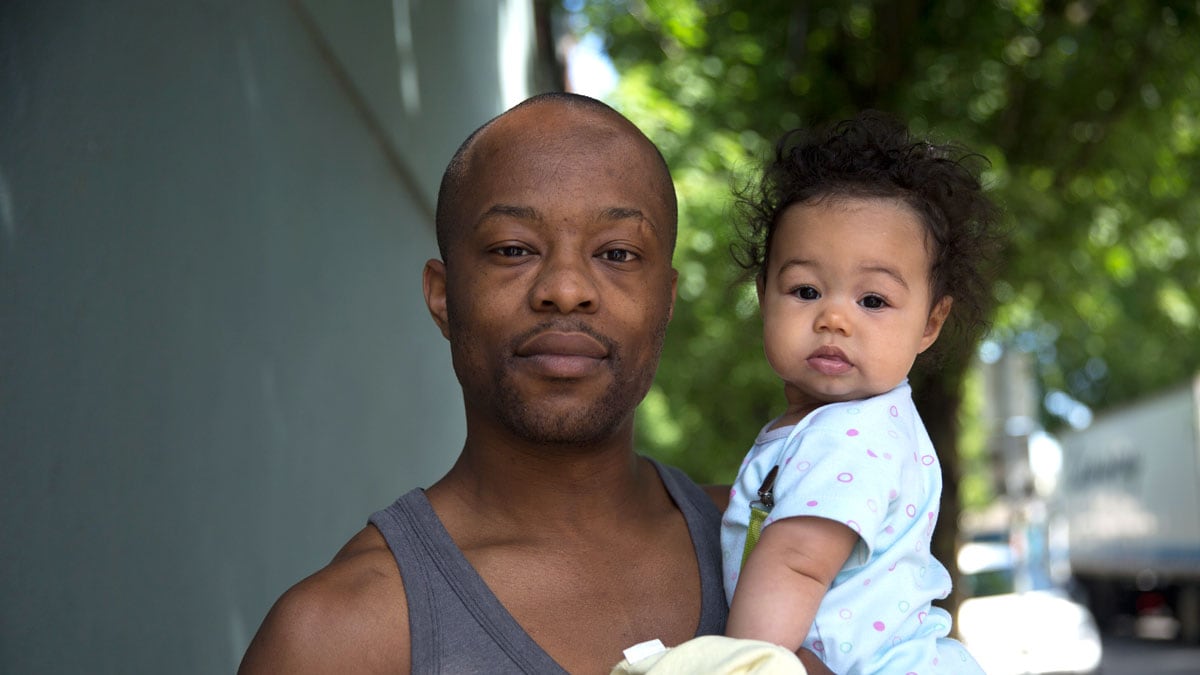For her exhibit, Black Portlanders, Black Portlands photographer Intisar Abioto has taken on a daunting task: "I wanna refer to the beauty and the depth of our complexity, of something that can't be explained, that won't be defined, that can't be pinned down," she says.
Abioto sits on the ledge of a large window in the Littman Gallery that overlooks PSU's park blocks. Wrapped around the white-walled gallery like an asteroid belt are over 150 prints of photos Abioto has taken for her blog The Black Portlanders.
Since she started the blog almost five years ago, she's photographed hundreds of people, from politicians to artists to community leaders to survivors of the Vanport flood and strangers she's passed on the street. For her exhibit at Littman, she had to fit just a fraction of those five years of photographs, chance interactions, legacies and lives into a single room. Abioto says it wasn't easy.
"I feel like Black Portlanders are awesome and amazing, and our presence is important. The level of the art needs to match the importance of these individuals," says Abioto. "I stayed here overnight one night, just moving things by an inch or something."
The photos in Black Portlanders, Black Portlands range in size from a few feet across to barely larger than a postcard. They're vibrant and warmly lit, but not oversaturated. Some are conventional portraits, like a particularly striking up-close photo of Johnnie Maxey, who housed people displaced by the Vanport flood.
But there are also photos that depict a clear scene, like the one of activist Rachel Gilmer on a street at night raising her fist in the air and wearing an "I Can't Breathe" pin. In another, actor and artist Vin Shambry stands with his infant daughter cradled in his arm. They gaze serenely into Abioto's camera.
Related: An interview with Intisar Abioto, photographer and founder of The Black Portlanders.
Black Portlanders, Black Portlands is only the third gallery show of Abioto's work. "I'm still learning how to do it—how to hold these images, how to take care of them," says Abioto. "I just keep wanting it to be the best that it can be, even if it's daunting."
But the more Abioto talks about her art, it becomes clear that "still learning" is its own form of mastery. "I want to keep exploring Blackness. I want to keep exploring not just the word, but the infinite nature of what the word refers to and cannot ever explain," she says.
In that way, Black Portlanders isn't just about the photos themselves, but how Abioto interacts with them. Every time she holds a show, she tries to invite as many of the people in the photographs as she can.
"In this culture and this time period where people are being so diminished and so invalidated," says Abioto, "It's absolutely my intent to do the complete opposite."
You can see Abioto's care for the people she's photographed, even in the way she's displayed each work. The photos are printed on matte, unframed paper. They're hung by clear white thumbtacks and black paper clips. Many are labeled with small captions that Abioto has handwritten in pencil on the gallery walls. Some say the name of the person in the photo, others simply say things like "sisters." It appears to be done impulsively, like a scrawled label on the back of a family photo.
"These are all moments from my life," says Abioto. "I sat across from all these people. I spoke with them. I asked them their names. I spent time with them." But they are just moments, and that isn't something Abioto is trying to change. By design, photography turns a fleeting moment into something permanent. But Abioto actively resists falling into that pattern. "I can't pin these people down. That would be a violence for me to say I know who these people are," she says.
Many of the photos have imperfections that seem like they're meant to remind you that what you see on the gallery wall is just a fragment of the person, let alone the moment the photo was taken. There's a portrait of John Bryant, grandmaster of the Sons of Haiti Masonic Lodge on Mississippi Avenue, in which he squarely faces the camera in front of a teal wall. It would be a conventional portrait if it weren't for the fact that Abioto's lens caught him in a moment when his eyes were closed.
It's that sense of how temporary Abioto's work is that makes her art so powerful. Her art is not just about the image that ends up on the gallery wall, it's about that moment when Abioto walked up to people who have shaped this city or to a stranger on the street, asked them their name and if she could take their picture. More than just portraits, the photos are stills from a moment when two lives intersected.
"Human connection is an opening. Art is an opening," says Abioto. "It allows surprise, it allows room for what we don't understand, it allows room for what we could understand."
"There's so much information and detail in all these people," she adds. "This is just a blip."
SEE IT: Black Portlanders, Black Portlands is at the Littman Gallery, 1825 SW Broadway, Room 250, theblackportlanders.com. Through Nov. 30.
